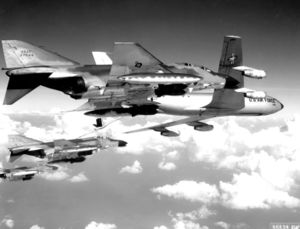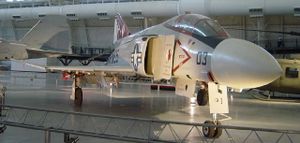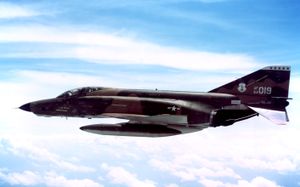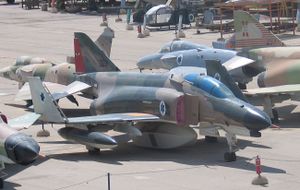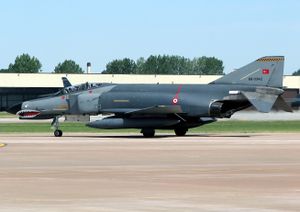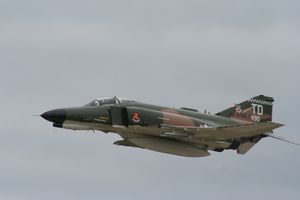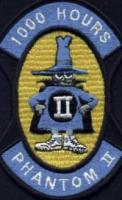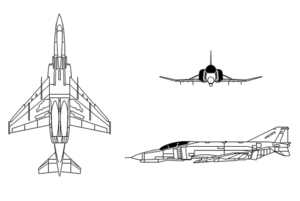PlaneSpottingWorld welcomes all new members! Please gives your ideas at the Terminal.
F-4 Phantom II
| F-4 Phantom II | |
|---|---|
| F-4E from 347th TFW dropping 500-lb Mark 82 bombs | |
| Type | Fighter-bomber |
| Manufacturer | McDonnell Aircraft/ McDonnell Douglas |
| Maiden flight | 27 May 1958 |
| Status | 1,100 active in foreign service, and as drones, as of 2001 |
| Primary users | United States Air Force United States Navy United States Marine Corps |
| Produced | 1958–1981 |
| Number built | 5,195 |
| Unit cost | US$2.4 million when new (F-4E) |
The McDonnell Douglas F-4 Phantom II[1][2] is an American two-seat, twin-engined supersonic long-range all-weather fighter-bomber originally developed for the U.S. Navy by McDonnell Aircraft.[2]
The Phantom remained in production from 1958 to 1981, with a total of 5,195 built, and was used by the U.S. military from 1960 to 1996, serving with the U.S. Air Force and Marine Corps as well as the Navy.[3] It was used extensively by all three U.S. services operating in Vietnam, ending the war as the principal air superiority fighter for both the Navy and Air Force, as well as being important in the ground attack and reconnaissance roles.[3]
The Phantom continued to form a major part of U.S. military air power throughout the 1970s and 80s, being gradually replaced by more modern aircraft such as the F-15 Eagle and F-16 Fighting Falcon in the U.S. Air Force and the F-14 Tomcat and F/A-18 Hornet in the U.S. Navy. It remained in service in the reconnaissance and Wild Weasel roles in the 1991 Gulf War.[4][5]
The Phantom was also operated by the armed forces of 11 other nations. Israeli Phantoms saw extensive combat in numerous Arab–Israeli conflicts, while Iran used its large fleet of Phantoms in the Iran–Iraq War. Phantoms remain in front line service with seven countries, and in use as an unmanned target in the U.S. Air Force.[6]
Contents
Overview
The F-4 Phantom was designed as a fleet defense fighter for the U.S. Navy, and first entered service in 1960. By 1963, it had been adopted by the U.S. Air Force for the fighter-bomber role. When production ended in 1981, 5,195 Phantom IIs had been built, making it the most numerous American supersonic military aircraft.[7] Until the advent of the F-15 Eagle, the F-4 also held a record for the longest continuous production with a run of 24 years. Innovations in the F-4 included an advanced pulse-doppler radar and extensive use of titanium in its airframe.[8]
Despite the imposing dimensions and a Maximum Takeoff Weight of over 60,000 pounds (27,000 kg),[9] the F-4 was capable of reaching a top speed of Mach 2.23 and had an initial climb rate of over 41,000 feet per minute (210 m/s).[10] Shortly after its introduction, the Phantom set 15 world records,[11] including an absolute speed record of 1,606.342 miles per hour (2,585.086 km/h), and an absolute altitude record of 98,557 feet (30,040 m).[12] Although set in 1959–1962, five of the speed records were not broken until 1975.[11]
The F-4 could carry up to 18,650 pounds (8,480 kg) of weapons on nine external hardpoints, including air-to-air and air-to-ground missiles, and unguided, guided, and nuclear bombs.[13] Since the F-8 Crusader was to be used for close combat, the F-4 was designed, like other interceptors of the day, without an internal cannon;[14][15] however, should it be engaged in visual range dogfights, the radar was assisted by the Weapons Systems Officer in spotting opposing fighters. It became the primary fighter-bomber of both the Navy and Air Force by the end of the Vietnam War.[citation needed]
Due to its distinctive appearance and widespread service with United States military and its allies, the F-4 is one of the best-known icons of the Cold War. It served in the Vietnam War and Arab–Israeli conflicts, with F-4 crews achieving 393 aerial victories and completing countless ground attack sorties.[14]
The F-4 Phantom has the distinction of being the last United States fighter to attain ace status in the 20th century. During the Vietnam War, the USAF had one pilot and two Weapon Systems Officers (WSOs),[16] and the USN had one pilot and Radar Intercept Officer (RIO)[17] become aces by shooting down five or more enemy aircraft in air-to-air combat. It was also a capable tactical reconnaissance and Wild Weasel (suppression of enemy air defenses) platform, seeing action as late as 1991, during Operation Desert Storm.[4][5]
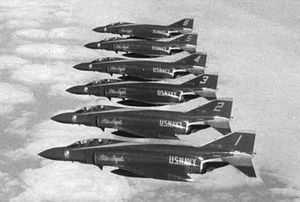
The F-4 Phantom II was also the only aircraft used by both of the USA's flight demonstration teams.[18] The USAF Thunderbirds (F-4E) and the USN Blue Angels (F-4J) both switched to the Phantom for the 1969 season; the Thunderbirds flew it for five seasons,[19] the Blue Angels for six.[20]
The baseline performance of a Mach 2-class fighter with long range and a bomber-sized payload would be the template for the next generation of large and light/middle-weight fighters optimized for daylight air combat. The Phantom would be replaced by the F-15 Eagle and F-16 Fighting Falcon in the U.S. Air Force. In the U.S. Navy, it would be replaced by the F-14 Tomcat and the F/A-18 Hornet which revived the concept of a dual-role attack fighter.[21]
Design and development
The origins of McDonnell’s F-4 can be traced to a 1953 request by the Navy for an upgrade of the McDonnell F3H Demon carrier-borne fighter. Although the Vought F8U Crusader won the contract, the "Super Demon" (as McDonnell’s entrant was dubbed) was developed as a ground attack aircraft under the designation AH, which by 1955 had evolved into an all-weather air superiority fighter designated F4H. The F4H first flew in 1958 and remained in production from 1959 until 1981. Dave Lewis was the chief of preliminary design and, ultimately, the program manager for development and the sales effort.[22]
Super Demon
In 1953, McDonnell Aircraft began work on revising its F3H Demon naval fighter, seeking expanded capabilities and better performance. The company developed several projects including the F3H-E with a Wright J67 engine, the F3H-G with two Wright J65 engines, and the F3H-H with two General Electric J79 engines.[22] The J79-powered version promised a top speed of Mach 1.97. On 19 September 1953, McDonnell approached the United States Navy with a proposal for the "Super Demon". Uniquely, the aircraft was to be modular—it could be fitted with one- or two-seat noses for different missions, with different nose cones to accommodate radar, photo cameras, four 20 millimeter cannon, or 56 FFAR unguided rockets in addition to the nine hardpoints under the wings and the fuselage. The Navy was sufficiently interested to order a full-scale mock-up of the F3H-G/H but felt that the upcoming Grumman XF9F-9 and Vought XF8U-1 already satisfied the need for the supersonic fighter.[22]
The McDonnell design was therefore reworked into an all-weather fighter-bomber with 11 external hardpoints for weapons and on 18 October 1954, the company received a letter of intent for two YAH-1 prototypes. On 26 May 1955, four Navy officers arrived at the McDonnell offices and, within an hour, presented the company with an entirely new set of requirements. Because the Navy already had the A-4 Skyhawk for ground attack and F-8 Crusader for dogfighting, the project now had to fulfill the need for an all-weather fleet defense interceptor. A second crewman was added to operate the powerful radar.[22][2]
Phantom origins
In 1952, McDonnell’s Chief of Aerodynamics, Dave Lewis was appointed by CEO J.S. McDonnell to be the company’s Preliminary Design Manager. With no new aircraft competitions on the horizon, internal studies concluded that the Navy had the greatest need for a new and different aircraft type; an Attack Fighter. At the time, the Navy had separate Fighter and Attack branches, each with separate systems and operational requirements. After many iterations and various "enemy capability" assumptions, an "unwanted" Attack Fighter was presented to the Navy. The McDonnell design called for two engines. The primary air-to-air armament was provided by the new Sparrow III missiles semi-recessed in the fuselage. The air-to-ground armament was to be as many bombs as could be carried on stations that would be mounted under the wings and aft of the Sparrow stations on the fuselage. No guns were offered. It took two years of hard work negotiating with the Bureau of Aeronautics and the Naval Air Warfare Division in the Pentagon, but the F-4 was sold with a similar configuration as was originally proposed.Template:Verify credibility[23]
XF4H-1 prototype
The XF4H-1 was designed to carry four semi-recessed AAM-N-6 Sparrow III radar-guided missiles, and to be powered by two J79-GE-8 engines. As in the F-101 Voodoo, the engines sat low in the fuselage to maximize internal fuel capacity and ingested air through fixed geometry intakes. The thin-section wing had a leading edge sweep of 45 degrees and was equipped with a boundary layer control system for better low-speed handling.[22]
Wind tunnel testing had revealed lateral instability requiring the addition of five degrees dihedral to the wings.[24] To avoid redesigning the titanium central section of the aircraft, McDonnell engineers angled up only the outer portions of the wings by 12 degrees which averaged to the required five degrees over the entire wingspan. The wings also received the distinctive "dogtooth" for improved control at high angles of attack. The all-moving tailplane was given 23 degrees of anhedral to improve control at high angles of attack while still keeping the tailplane clear of the engine exhaust.Cite error: Closing </ref> missing for <ref> tag In the end, the aircraft was given the less controversial name "Phantom II," the first "Phantom" being another McDonnell jet fighter, the FH-1.
Flight testing
On 25 July 1955, the Navy ordered two XF4H-1 test aircraft and five YF4H-1 pre-production fighters. The Phantom made its maiden flight on 27 May 1958 with Robert C. Little at the controls. A hydraulic problem precluded retraction of the landing gear but subsequent flights went more smoothly. Early testing resulted in redesign of the air intakes, including the distinctive addition of 12,500 bleed air holes on each ramp; and the aircraft soon squared off against the Vought XF8U-3 Crusader III. Due to operator workload, the Navy wanted a two-seat aircraft and on 17 December 1958 the F4H was declared a winner. Delays with the J79-GE-8 engines meant that the first production aircraft were fitted with J79-GE-2 and -2A engines, each having 16,100 pound-force (71.8 kN) of afterburner thrust. In 1959, the Phantom began carrier suitability trials with the first complete launch-recovery cycle performed on 15 February 1960 from USS Independence.[24]
Into production
Early in production, the radar was upgraded to a larger AN/APQ-72, necessitating the bulbous nose, and the canopy was reworked to improve visibility and make the rear cockpit less claustrophobic.[25] The Phantom underwent a great many changes during its career, summarized in the "Variants" section below.
The United States Air Force received Phantoms as the result of Robert McNamara’s push to create a unified fighter for all branches of the military. After an F-4B won the "Operation Highspeed" fly-off against the F-106 Delta Dart, the USAF borrowed two Naval F-4Bs, temporarily designating them F-110A Spectre in January 1962, and developed requirements for their own version. Unlike the Navy focus on interception, the USAF emphasized a fighter-bomber role. With McNamara’s unification of designations on 18 September 1962, the Phantom became the F-4 with the Naval version designated F-4B and USAF F-4C. The first Air Force Phantom flew on 27 May 1963, exceeding Mach 2 on its maiden flight.[26]
Phantom II production ended in the United States in 1979 after 5,195 had been built (5,057 by McDonnell Douglas and 138 in Japan by Mitsubishi), making it the second most produced and exported American military-jet; the F-86 Sabre still remains the most numerous jet-powered warplane produced and exported by the United States. Of these, 2,874 went to the USAF, 1,264 to the Navy and Marine Corps, and the rest to foreign customers.[18] The last U.S.-built F-4 went to Turkey, while the last F-4 ever built was completed in 1981 as an F-4EJ by Mitsubishi Heavy Industries in Japan. As of 2001, about 1,100 Phantoms remained in service worldwide, including QF-4 drones operated by the U.S. military.[27]
World record breaker
To show off their new fighter, the Navy led a series of record-breaking flights early in Phantom development:[18]
- Operation Top Flight: On 6 December 1959, the second XF4H-1 performed a zoom climb to a world record 98,557 feet (30,040 m).[12] The previous record of 94,658 feet (28,852 m) was set by a Soviet Sukhoi T-43-1 prototype. Commander Lawrence E. Flint Jr. accelerated his aircraft to Mach 2.5 at 47,000 feet (14,330 m) and climbed to 90,000 feet (27,430 m) at a 45 degree angle. He then shut down the engines and glided to the peak altitude. As the aircraft fell through 70,000 feet (21,300 m), Flint restarted the engines and resumed normal flight.[14]
- On 5 September 1960, an F4H-1 averaged 1,216.78 miles per hour (1,958.16 km/h) over a 500 kilometer (311 mi) closed-circuit course.[12]
- On 25 September 1960, an F4H-1 averaged 1,390.21 miles per hour (2,237.26 km/h) over a 100 kilometer (62 mi) closed-circuit course.[12]
- Operation LANA: To celebrate the 50th anniversary of Naval aviation (L is the Roman numeral for 50 and ANA stood for Anniversary of Naval Aviation) on 24 May 1961, Phantoms flew across the continental United States in under three hours and included several tanker refuelings. The fastest of the aircraft averaged 869.74 miles per hour (1,400.28 km/h) and completed the trip in 2 hours 47 minutes, earning the pilot (and future NASA Astronaut), Lt. Richard Gordon, and navigator, Lt. Bobbie Long, the 1961 Bendix trophy.[28]
- Operation Sageburner: On 28 August 1961, a Phantom averaged 902.769 miles per hour (1,452.826 km/h) over a three-mile (1.86 km) course flying below 125 feet (40 m) at all times.[12] Navy Commander J.L. Felsman was killed during the first attempt at this record on 18 May 1961 when his aircraft disintegrated in the air after pitch damper failure.[28]
- Operation Skyburner: On 22 December 1961, a modified Phantom with water injection set an absolute world record speed of 1,606.342 miles per hour (2,585.086 km/h).[12]
- On 5 December 1961, another Phantom set a sustained altitude record of 66,443.8 feet (20,252.1 m).[12]
- Operation High Jump: A series of time-to-altitude records was set in early 1962; 34.523 seconds to 3,000 meters (9,840 ft), 48.787 seconds to 6,000 meters (19,680 ft), 61.629 seconds to 9,000 meters (29,530 ft), 77.156 seconds to 12,000 meters (39,370 ft), 114.548 seconds to 15,000 meters (49,210 ft), 178.5 seconds to 20,000 meters (65,600 ft), 230.44 seconds to 25,000 meters (82,000 ft), and 371.43 seconds to 30,000 meters (98,400 ft).[12] Although not officially recognized, the Phantom zoom-climbed to over 100,000 feet (30,480 m) during the last attempt.[29]
All in all, the Phantom set 16 world records. With the exception of Skyburner, all records were achieved in unmodified production aircraft. Five of the speed records remained unbeaten until the F-15 Eagle appeared in 1975.[11]
Flying the Phantom
In air combat, the Phantom's greatest advantage was its thrust, which permitted a skilled pilot to engage and disengage from the fight at will.[30]
The massive aircraft, designed to fire radar-guided missiles from beyond visual range, lacked the agility of its Soviet opponents and was subject to adverse yaw during hard maneuvering. Although thus subject to irrecoverable spins during aileron rolls, pilots reported the aircraft to be very communicative and easy to fly on the edge of its performance envelope. In 1972, the F-4E model was upgraded with leading edge slats on the wing, greatly improving high-angle-of-attack maneuverability at the expense of top speed.[31]
The J79 engines produced copious amounts of black smoke at military power which made the Phantoms easy to spot from a distance, a severe disadvantage in air combat against smaller aircraft. Pilots could eliminate the smoke by using afterburner, but at the cost of fuel efficiency.[32] Some pilots adopted the procedure of running one engine in dry thrust at normal power setting, and the other in afterburner, resulting in the same total thrust as using both engines at full rated military power without generating the tell-tale smoke trail.
The F-4's biggest weakness, as it was initially designed, was its lack of an internal cannon. For a brief period, doctrine held that turning combat would be impossible at supersonic speeds and little effort was made to teach pilots air combat maneuvering. In reality, engagements quickly became subsonic. Furthermore, the relatively new heat-seeking and radar-guided missiles at the time were frequently reported as unreliable and pilots had to use multiple shots just to hit one target. To compound the problem, rules of engagement in Vietnam precluded long-range missile attacks in most instances, as visual identification was normally required. Many pilots found themselves on the tail of an enemy aircraft but too close to fire short-range Falcons or Sidewinders. Although in 1967 USAF F-4Cs began carrying SUU-16 or SUU-23 external gunpods containing a 20 millimeter M61 Vulcan Gatling cannon, USAF cockpits were not equipped with lead-computing gunsights, virtually assuring a miss in a maneuvering fight. Some Marine Corps aircraft carried two pods for strafing. In addition to the loss of performance due to drag, combat showed the externally mounted cannon to be inaccurate, yet far more cost-effective than missiles. The lack of cannon was finally addressed by adding an internally mounted 20 millimeter M61 Vulcan on the F-4E.[31]
Phantom costs
| F-4C | RF-4C | F-4D | F-4E | |
|---|---|---|---|---|
| Unit R&D cost | 61,200 by 1973 | 22,700 by 1973 | ||
| Airframe | 1,388,725 | 1,679,000 | 1,018,682 | 1,662,000 |
| Engines | 317,647 | 276,000 | 260,563 | 393,000 |
| Electronics | 52,287 | 293,000 | 262,101 | 299,000 |
| Armament | 139,706 | 73,000 | 133,430 | 111,000 |
| Ordnance | 6,817 | 8,000 | ||
| Flyaway cost | 1.9 million | 2.3 million | 1.7 million | 2.4 million |
| Modification costs | 116,289 by 1973 | 55,217 by 1973 | 233,458 by 1973 | 7,995 by 1973 |
| Cost per flying hour | 924 | 867 | 896 | 896 |
| Maintenance cost per flying hour | 545 | 545 | 545 | 545 |
Note: Costs are in 1965 United States dollars and have not been adjusted for inflation.[33]
Operational history
On 30 December 1960, the VF-121 Pacemakers became the first Phantom operator with its F4H-1Fs (F-4As). The VF-74 Be-devilers at NAS Oceana became the first deployable Phantom squadron when it received its F4H-1s (F-4Bs) on 8 July 1961.[34]Template:Verify credibility[35] The squadron completed carrier qualifications in October 1961 and Phantom’s first full carrier deployment between August 1962 and March 1963 aboard USS Forrestal.[34] The second deployable US Atlantic Fleet squadron to receive F-4Bs was the VF-102 Diamondbacks who promptly took their new aircraft on the shakedown cruise of Enterprise.[34] The first deployable US Pacific Fleet squadron to receive the F-4B was the VF-114 Aardvarks, which participated in the September 1962 cruise aboard Kitty Hawk.Template:Verify credibility[36]
By the time of the Tonkin Gulf incident, 13 of 31 deployable Navy squadrons were armed with the type. F-4Bs from Constellation made the first Phantom combat sortie of the Vietnam War on 5 August 1964, flying bomber escort in Operation Pierce Arrow.[37] The first Phantom air-to-air victory of the war took place on 9 April 1965 when an F-4B from VF-96 Fighting Falcons piloted by Lt JG Terence M. Murphy shot down a Chinese MiG-17 'Fresco'. The Phantom was then shot down, apparently by an AIM-7 Sparrow from one of its wingmen.[24] On 17 June 1965, an F-4B from VF-21 Freelancers piloted by Cdr Thomas C. Page and Lt John C. Smith shot down the first North Vietnamese MiG of the war.[38]
On 10 May 1972, Randy "Duke" Cunningham and William P. Driscoll flying an F-4J with the radio call sign "Showtime 100" shot down three MiG-17s to become the first flying aces of the war. Their fifth victory was believed at the time to be over a mysterious North Vietnamese ace Colonel Toon, now considered mythical. On the return flight, the Phantom was damaged by an enemy surface-to-air missile. To avoid being captured, Cunningham and Driscoll flew their burning aircraft upside down (the damage made the aircraft uncontrollable in a conventional attitude) until they could eject over water. Cunningham and Driscoll became USN aces by shooting down five or more enemy aircraft.[17]
During the war, Navy Phantom squadrons participated in 84 combat tours with F-4Bs, F-4Js, and F-4Ns. The Navy claimed 40 air-to-air victories at the cost of 71 Phantoms lost in combat (5 to aircraft, 13 to SAMs, and 53 to AAA). An additional 54 Phantoms were lost in accidents. Of the 40 aircraft shot down by Navy and Marine Phantom crews, 22 were MiG-17s, 14 MiG-21s, 2 Antonov An-2s, and 2 MiG-19s. Of these, eight aircraft were downed by AIM-7 Sparrow missiles and 31 by AIM-9 Sidewinders.[39]
By 1983, the F-4Ns had been completely replaced by F-14 Tomcats, and by 1986 the last F-4Ss were exchanged for F/A-18 Hornets. On 25 March 1986, an F-4S belonging to VF 151 Vigilantes became the last Navy Phantom to launch from an aircraft carrier (Midway). On 18 October 1986, an F-4S from VF-202 Superheats made the last-ever Phantom carrier landing aboard America. In 1987, the last of the Naval Reserve-operated F-4Ss were replaced by F-14s. The last Phantoms in service with the Navy were the QF-4 target drones operated by the Naval Air Warfare Centers.[24] These were retired in 2004.[40]
United States Marine Corps
The Marines received their first F-4Bs in June 1962, with the VMFA-314 Black Knights becoming the first operational squadron. In addition to attack variants, the Marines also operated several tactical reconnaissance RF-4Bs. Marine Phantoms from VMFA-531 Gray Ghost arrived in Vietnam on 10 April 1965, flying close air support missions from land bases as well as from America. Marine F-4 pilots claimed three enemy MiGs (two while on exchange duty with the USAF) at the cost of 75 aircraft lost in combat, mostly to ground fire, and four in accidents. On 18 January 1992, the last Marine Phantom, an F-4S, was retired by VMFA-112 Cowboys. The squadron was re-equipped with F/A-18 Hornets.[41]
United States Air Force
At first reluctant to adopt a Navy fighter, the USAF quickly embraced the design and became the largest Phantom user. The first Air Force Phantoms in Vietnam were F-4Cs from the 555th "Triple Nickel" Tactical Fighter Squadron,[42] which arrived in December 1964.[43] Unlike the Navy, the Air Force initially flew its Phantoms with a rated pilot in the back seat rather than a weapon/targeting systems officer (later designated as weapon systems officer or WSO), and all USAF Phantoms retained dual flight controls.
USAF F-4Cs scored their first victories against North Vietnamese MiG-17s on 10 July 1965 using AIM-9 Sidewinder air-to-air missiles.[44] On 24 July 1965, a Phantom from the 47th Tactical Fighter Squadron on temporary assignment in Vietnam became the first American aircraft to be downed by an enemy SAM, and on 5 October 1966 an 8th Tactical Fighter Wing F-4C became the first U.S. jet lost to an air-to-air missile, fired by a MiG-21.
Early aircraft suffered from leaks in wing fuel tanks that required re-sealing after each flight and 85 aircraft were found to have cracks in outer wing ribs and stringers.[33] There were also problems with aileron control cylinders, electrical connectors, and engine compartment fires. Reconnaissance RF-4Cs made their debut in Vietnam on 30 October 1965, flying the hazardous post-strike reconnaissance missions.
Although the F-4C was essentially identical to the Navy F-4B in flight performance and carried the Navy-designed Sidewinder missiles, USAF-tailored F-4Ds initially arrived in June 1967 equipped with AIM-4 Falcons. However, the Falcon like its predecessors was designed to shoot down bombers flying straight and level. Its reliability proved no better than others, and its complex firing sequence and limited seeker-head cooling time made it virtually useless in combat against agile fighters. The F-4Ds reverted to using Sidewinders under the "Rivet Haste" program in early 1968, and by 1972 the AIM-7E-2 "Dogfight Sparrow" had become the preferred missile for USAF pilots. Like other Vietnam War Phantoms, the F-4Ds were urgently fitted with radar homing and warning (RHAW) antennae to detect the Soviet-built SA-2 Guideline SAMs.[45]
From the initial deployment of the F-4C to Southeast Asia, USAF Phantoms performed both air superiority and ground attack roles, supporting not only ground troops in South Vietnam but also conducting bombing sorties in Laos and North Vietnam. As the F-105 force underwent severe attrition between 1965 and 1968, the bombing role of the F-4 proportionately increased until after November 1970 (when the last F-105D was withdrawn from combat) it became the primary USAF ordnance delivery system. In October 1972 the first squadron of EF-4C Wild Weasel aircraft deployed to Thailand on temporary duty.[46]
Sixteen squadrons of Phantoms were permanently deployed between 1965 and 1973, and 17 others deployed on temporary combat assignments.[47][48] Peak numbers of combat F-4s occurred in 1972, when 353 were based in Thailand.[49] A total of 445 Air Force Phantom fighter-bombers were lost, 370 in combat and 193 of those over North Vietnam (33 to MiGs, 30 to SAMs, and 307 to AAA).[48][49]
The RF-4C was operated by four squadrons,[50] and of the 83 losses, 72 were in combat including 38 over North Vietnam (7 to SAMs and 65 to AAA).[49] By war's end the U.S. Air Force had lost a total of 528 F-4 and RF-4C Phantoms. When combined with US Naval/Marine losses of 233 Phantoms; 761 F-4/RF-4 Phantoms were lost in the Vietnam War.
On 28 August 1972, Steve Ritchie became the first USAF ace of the war.[16] On 9 September 1972, WSO Charles B. DeBellevue became the highest-scoring American ace of the war with six victories.[16] WSO Jeffrey Feinstein became the last USAF ace of the war on 13 October 1972.[51] USAF F-4s scored 107½ MiG kills in Southeast Asia (50 by Sparrow, 31 by Sidewinder, five by Falcon, 15.5 by gun, and six by other means).[49]
| Aircraft | Weapons/Tactics | MiG-17 | MiG-19 | MiG-21 | Total |
|---|---|---|---|---|---|
| F-4C | AIM-7 Sparrow | 4 | 0 | 10 | 14 |
| AIM-9 Sidewinder | 12 | 0 | 10 | 22 | |
| 20 mm gun | 3 | 0 | 1 | 4 | |
| Maneuvering tactics | 2 | 0 | 0 | 2 | |
| F-4D | AIM-4 Falcon | 4 | 0 | 1 | 5 |
| AIM-7 Sparrow | 4 | 2 | 20 | 26 | |
| AIM-9 Sidewinder | 0 | 2 | 3 | 5 | |
| 20 mm gun | 4.5 | 0 | 2 | 6.5 | |
| Maneuvering tactics | 0 | 0 | 2 | 2 | |
| F-4E | AIM-7 Sparrow | 0 | 2 | 8 | 10 |
| AIM-9 Sidewinder | 0 | 0 | 4 | 4 | |
| AIM-9+20 mm gun | 0 | 0 | 1 | 1 | |
| 20 mm gun | 0 | 1 | 4 | 5 | |
| Maneuvering tactics | 0 | 1 | 0 | 1 | |
| Total | 33.5 | 8 | 66 | 107.5 |
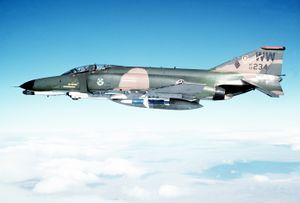
On 31 January 1972, the 170th Tactical Fighter Squadron/183d Tactical Fighter Group of Illinois Air National Guard became the first Air National Guard unit to transition to Phantoms.[52] The ANG service lasted until 31 March 1990, when the Phantom was replaced by the F-16 Fighting Falcon. Then, on 15 August 1990, 24 F-4G Wild Weasel Vs and six RF-4Cs were mobilized to the Middle East for Operation Desert Storm. The reason for this was that the F-4G was the only aircraft in the USAF inventory equipped for the suppression of enemy air defenses (SEAD) role since the EF-111 Raven lacked the offensive capability of AGM-88 HARM missiles. The RF-4C was the only aircraft equipped with the ultra-long-range KS-127 LOROP (long-range oblique photography) camera. In spite of flying almost daily missions, only one RF-4C was lost in a fatal accident before the start of hostilities. One F-4G was lost when enemy fire damaged the fuel tanks and the aircraft ran out of fuel near a friendly airbase. The last USAF Phantoms, F-4G Wild Weasel Vs from 561st Fighter Squadron, were retired on 26 March 1996. The last operational flight of the F-4G Wild Weasel was from the 190th Fighter Squadron, Idaho Air National Guard, in April 1996.[53] The last operational USAF/ANG F-4 to land was flown by Maj. Mike Webb and Maj. Gary Leeder, Idaho ANG. Like the Navy, the Air Force continues to operate QF-4 target drones, serving with the 82nd Aerial Targets Squadron,[54] it being expected that the F-4 will remain in the target role with the 82nd ATRS until 2013/14.[6]
Phantom in non-U.S. air forces

| ||
| Received | In service as of 2001 | |
|---|---|---|
| Australia | 24 F-4E | None (returned to USA) |
| Egypt | 45 F-4E | 30 F-4E |
| Germany | 88 RF-4E 175 F-4F |
145 F-4F (110 upgraded to ICE) |
| Greece | 121 F-4E and RF-4E | 62 F-4E and RF-4E (39 upgraded to Peace Icarus 2000) |
| Iran | 32 F-4D 177 F-4E 16 RF-4E |
Estimated 40 F-4D and F-4E |
| Israel | 274 F-4E 12 RF-4E |
40 F-4E 53 Kurnass 2000 (all retired) |
| Japan | 140 F-4EJ 14 RF-4EJ |
109 F-4EJ |
| South Korea | 27 RF-4C 92 F-4D 103 F-4E |
60 F-4D 70 F-4E 18 RF-4E |
| Spain | 40 F-4C 18 RF-4C |
14 RF-4C (all retired and destroyed as targets) |
| Turkey | 233 F-4E and RF-4E | 163 F-4E (54 upgraded to Terminator 2020) 44 RF-4E |
| United Kingdom | 15 F-4J(UK) 52 F-4K 118 F-4M |
None |
The Phantom served with the air forces of many countries, including Australia, Egypt, Germany, United Kingdom, Greece, Iran, Israel, Japan, Spain, South Korea and Turkey.
Australia
The Royal Australian Air Force (RAAF) leased 24 USAF F-4Es from 1970 to 1973 while waiting for their order for the General Dynamics F-111C to be delivered. They were so well-liked that the RAAF considered adopting the F-4E instead.[55]
Egypt
In 1979, the Egyptian Air Force purchased 35 former USAF F-4Es along with a number of Sparrow, Sidewinder, and Maverick missiles from the US for $594 million as part of the "Peace Pharaoh" program.[56] An additional seven surplus USAF aircraft were purchased in 1988.[57] Three attrition replacements had been received by the end of the 1990s.[58]
Germany
The German Luftwaffe initially ordered the reconnaissance RF-4E in 1969, receiving a total of 88 aircraft which were delivered from January 1971.[59] In 1982, the initially unarmed RF-4Es were given a secondary ground attack capability, and were retired in 1994.[60]
In 1973, under the "Peace Rhine" program the Luftwaffe purchased the lightened and simplified F-4F which was upgraded in the mid-1980s. Germany also initiated the "ICE" (Improved Combat Efficiency) program in 1983. The 110 ICE-upgraded F-4Fs entered service in 1992,[27] and are expected to remain in service until 2012.[61] Twenty-four German-owned F-4Fs were operated by the 49th Tactical Fighter Wing of the USAF at Holloman AFB to train Luftwaffe crews until 2002. In 1975, Germany also received 10 F-4Es for training in the U.S. In the late 1990s, these were withdrawn from service, being replaced by F-4Fs.[62]
Greece
In 1971, the Hellenic Air Force purchased brand new F-4E and RF-4E Phantoms, with surplus RF-4Es and F-4Es from the German Luftwaffe and U.S. ANG being given to Greece in the early 1990s. Several of the aircraft were modified to the F-4G Wild Weasel V standard. Following the success of the German ICE program, on 11 August 1997, DASA of Germany received a contract to upgrade 39 aircraft to the very similar "Peace Icarus 2000" standard.[24]
Iran
In the 1960s and 1970s, then U.S.-friendly Iran purchased 225 F-4D, F-4E and RF-4E Phantoms. The Islamic Republic of Iran Air Force Phantoms saw action in the Iran-Iraq war in the 1980s and are kept operational by overhaul and servicing from Iran’s aerospace industry.[63]
Israel
The Israeli Air Force has been the largest foreign user of the Phantom, flying both newly built and ex-USAF aircraft, as well as several one-off special reconnaissance variants. The first F-4Es, nicknamed "Kurnass" (Heavy hammer), and RF-4Es, nicknamed "Orev" (Raven), were delivered in 1969 under the "Peace Echo I" program. Additional Phantoms arrived during the 1970s under "Peace Echo II" through "Peace Echo V" and "Nickel Grass" programs. Israeli Phantoms saw extensive combat during Arab–Israeli conflicts, first seeing action during the War of Attrition.[64][65] In the 1980s, Israel began the "Kurnass 2000" modernization program which significantly updated avionics.[24] The last Israeli F-4s were retired in 2004.[66]
Japan
From 1968, the Japan Air Self-Defense Force purchased a total of 140 F-4EJ Phantoms without aerial refueling and ground attack capabilities.[67] Mitsubishi built 138 under license in Japan and 14 unarmed reconnaissance RF-4Es were imported. Of these, 96 F-4EJs have since been modified to the F-4EJ Kai (改、 "modified") standard. Seventeen F-4EJs have been converted to reconnaissance aircraft designated RF-4EJ, with similar upgrades as the F-4EJ Kai. As of 2007, Japan has a fleet of 90 F-4s currently in service and talks are underway to replace them with the Eurofighter Typhoon.[68]
South Korea
The Republic of Korea Air Force purchased its first batch of ex-USAF F-4D Phantoms in 1968 under the "Peace Spectator" program. The ex-USAF F-4Ds continued to be delivered until 1988. The "Peace Pheasant II" program also provided newly-built and ex-USAF F-4Es.[69]
Spain
The Ejercito del Aire (Spanish Air Force) acquired its first batch of ex-USAF F-4C Phantoms in 1971 under the "Peace Alfa" program. Designated C.12, the aircraft were retired in 1989. At the same time, the SAF received a number of ex-USAF RF-4Cs, designated RC.12. In 1995–1996, these aircraft received extensive avionics upgrades. Spain retired its RF-4s in 1992.[70][71]
Turkey
The Turkish Air Force received 40 F-4Es in 1974, with a further 32 F-4Es and 8 RF-4Es in 1977-78 under the "Peace Diamond III" program, followed by 40 ex-USAF aircraft in "Peace Diamond IV" in 1987, and a further 40 ex-U.S. Air National Guard Aircraft in 1991.[72] A further 32 RF-4Es were transferred to Turkey after being retired by the Luftwaffe between 1992 and 1994.[72] In 1995, IAI of Israel implemented an upgrade similar to Kurnass 2000 on 54 Turkish F-4Es which were dubbed the F-4E 2020 Terminator.[24]
United Kingdom
The United Kingdom bought versions based on the USN F-4J for use with the Royal Air Force and Fleet Air Arm. The FAA and RAF versions were given the designation F-4K and F-4M respectively, and entered service as the Phantom FG.1 (fighter/ground attack) and Phantom FGR.2 (fighter/ground attack/reconnaissance).[73][74][75]
After the Falklands War, 15 upgraded ex-USN F-4Js, known as the F-4J(UK) entered RAF service to compensate for one interceptor squadron redeployed to the islands.[27] The interceptor Phantoms were replaced by the Panavia Tornado F3 from the late 1980s onwards, and the last British Phantoms were retired in 1993.[24]
Civilian use
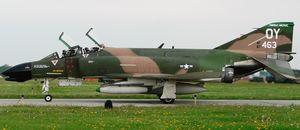
One aircraft, an F-4D, is operated by the Massachusetts-based non-profit organization Collings Foundation as a "living history" exhibit.[24][76] Funds to maintain and operate the aircraft, which is based in Houston, Texas, are raised through donations/sponsorships from public and commercial parties.[77][78]
Sandia National Laboratories used an F-4 mounted on a "rocket sled" in a crash test to see the results of an aircraft hitting a reinforced concrete structure, such as a nuclear power plant.[79]
Variants
- F-4A, B, J, N and S
- Variants for the US Navy and the US Marines. F-4B was upgraded to F-4N, and F-4J was upgraded to F-4S.
- F-110 Spectre, F-4C, D and E
- Variants for the US Air Force. F-4E introduced an internal M61 Vulcan cannon. F-4D and E were widely exported.
- F-4G Wild Weasel V
- A dedicated SEAD variant with updated radar and avionics, converted from F-4E. The designation F-4G was applied earlier to an entirely different Navy Phantom.
- F-4K and M
- Variants for British military re-engined with Rolls-Royce Spey turbofans.
- F-4EJ
- Simplified F-4E exported to and license-built in Japan.
- F-4F
- Simplified F-4E exported to Germany.
- F-4X
- Proposed reconnaissance variant with water injection capable of exceeding Mach 3.
- QF-4B, E, G and N
- Retired aircraft converted into remote-controlled target drones used for weapons and defensive systems research.
- RF-4B, C, and E
- Tactical reconnaissance variants.
Phantom culture
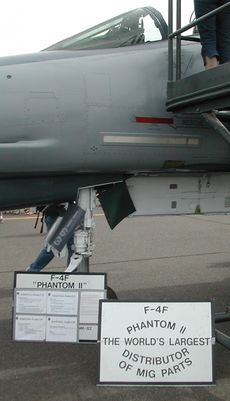
Phantom nicknames
The Phantom gathered a number of nicknames during its career. It was the "Rhino" because of the long nose and tough titanium construction, the "Double Ugly"[80] and "DUFF" (Double-Ugly Fat Fucker mimicking the B-52 "BUFF" Stratofortress)Template:Verify credibility[81] in reference to its dihedral wings and anhedral tail as well as a joke on its two crew members, the "World’s Leading Distributor of MiG Parts"[80] in tribute to its claimed record of downing large numbers of Soviet-built MiGs as part of its 277 air-to-air victories in U.S. service and an additional 116 with Israel,[14] the "Flying Anvil", "Flying Footlocker". "Lead Sled", the "Big Iron Sled" and the "Louisville Slugger".[82] As a reflection of excellent performance in spite of bulk, it was dubbed "the triumph of thrust over aerodynamics."Template:Verify credibility[8][83] German Luftwaffe crews called their F-4s the Eisensau ("Iron Pig"), Fliegender Ziegelstein ("Flying Brick") and Luftverteidigungsdiesel ("Air Defense Diesel").Template:Verify credibility[84][85]
Imitating the spelling of the aircraft’s name, McDonnell issued a series of patches. Pilots became "Phantom Phlyers", backseaters became "Phantom pherrets", fans of the F-4 "Phantom Phanatics", and call it the "Phabulous Phantom". Ground crewmen who worked on the aircraft are known as "Phantom Phixers".[18]
The Spook
As famous as the aircraft itself is its emblem, a whimsical cartoon ghost called "The Spook" which was created by McDonnell Douglas technical artist, Anthony "Tony" Wong, for shoulder patches. The name "Spook" was coined by the crews of either the 12th Tactical Fighter Wing or the 4453rd Combat Crew Training Wing at MacDill AFB. The figure is ubiquitous, appearing on every imaginable item associated with the F-4. The Spook has followed the Phantom around the world adopting local fashions; for example, the British adaptation of the U.S. "Phantom Man"[86] is a Spook that sometimes wears a bowler hat and smokes a pipe.[87]
Specifications (F-4E)
Data from The Great Book of Fighters[27] Quest for Performance,[88] and Encyclopedia of USAF Aircraft.[33]
General characteristics
- Crew: 2
- Length: 63 ft 0 in (19.2 m)
- Wingspan: 38 ft 4.5 in (11.7 m)
- Height: 16 ft 6 in (5.0 m)
- Wing area: 530.0 ft² (49.2 m²)
- Airfoil: NACA 0006.4-64 root, NACA 0003-64 tip
- Empty weight: 30,328 lb (13,757 kg)
- Loaded weight: 41,500 lb (18,825 kg)
- Max takeoff weight: 61,795 lb (28,030 kg)
- Powerplant: 2× General Electric J79-GE-17A axial compressor turbojets, 17,845 lbf (79.6 kN) each
- Zero-lift drag coefficient: 0.0224
- Drag area: 11.87 ft² (1.10 m²)
- Aspect ratio: 2.77
- Fuel capacity: 1,994 US gal (7,549 L) internal, 3,335 US gal (12,627 L) with three external tanks
- Maximum landing weight: 36,831 lb (16,706 kg)
Performance
- Maximum speed: Mach 2.23 (1,472 mph, 2,370 km/h) at 40,000 ft (12,190 m)
- Cruise speed: 506 kn (585 mph, 940 km/h)
- Combat radius: 367 nmi (422 mi, 680 km)
- Ferry range: 1,403 nmi (1,615 mi, 2,600 km) with 3 external fuel tanks
- Service ceiling: 60,000 ft (18,300 m)
- Rate of climb: 41,300 ft/min (210 m/s)
- Wing loading: 78 lb/ft² (383 kg/m²)
- Thrust/weight: 0.86
- Lift-to-drag ratio: 8.58
- Takeoff roll: 4,490 ft (1,370 m) at 53,814 lb (24,410 kg)
- Landing roll: 3,680 ft (1,120 m) at 36,831 lb (16,706 kg)
Armament
Preserved Phantoms
There are a number of F-4 Phantom IIs on display in the USA.[89]Template:Verify credibility Phantom II F-4C-15-MC 37699, which is on loan from the USAF Museum, is on display at the Midland Air Museum, Coventry, England.[90] Phantom II F4H-1, BuNo 145310, US Navy,[91] is located at French Valley Airport, Murrieta, California.[92]
References
Notes
- ↑ The aircraft was originally designated the AH, and later redesignated F4H. The F-4 designation came in 1961 when the designation systems for all branches of the military were unified by the order of Robert McNamara. Within McDonnell, the F-4 was referred to as Model 98.
- ↑ 3.0 3.1 Integrated Defense Systems: F-4 Phantoms Phabulous 40th. Boeing. Retrieved: 19 January 2008.
- ↑ 4.0 4.1 Donald Spring 1991, p. 26.
- ↑ 5.0 5.1 Donald Summer 1991, p. 22.
- ↑ 6.0 6.1 Carrara 2006, p. 48.
- ↑ Integrated Defense Systems: F-4 Phantoms Phabulous 40th: First to Last. Boeing. Retrieved: 19 November 2007.
- ↑ 8.0 8.1 Goebel, Greg. Phantom Variants, 1.3: The Phantom in Detail. Vectorsite.net. Retrieved: 19 January 2008.
- ↑ Donald and Lake 1996, p. 268.
- ↑ Dorr and Donald 1990, p. 198.
- ↑ 11.0 11.1 11.2 Integrated Defense Systems: F-4 Phantoms Phabulous 40th - Phantom "Phirsts". Boeing. Retrieved: 14 December 2007.
- ↑ 12.0 12.1 12.2 12.3 12.4 12.5 12.6 12.7 Integrated Defense Systems: F-4 Phantoms Phabulous 40th - World Record Holder. Boeing. Retrieved: 14 December 2007.
- ↑ McDonnell Douglas F-4D “Phantom II”. National Museum of the USAF. Retrieved: 20 January 2008
- ↑ 14.0 14.1 14.2 14.3 Baugher, Joe. Baugher's YF4H-1 Phantom II. Joe Baugher's Home Page. Retrieved: 23 January 2008.
- ↑ Goebel, Greg. Phantom origins. Vectorsite.net. Retrieved: 23 January 2008.
- ↑ 16.0 16.1 16.2 Dorr and Bishop 1996, p. 200–201.
- ↑ 17.0 17.1 Dorr and Bishop 1996, p. 188–189.
- ↑ 18.0 18.1 18.2 18.3 Integrated Defense Systems: F-4 Phantoms Phabulous 40th. Boeing. Retrieved: 22 May 2007.
- ↑ Baugher, Joe. Baugher's McDonnell F-4E Phantom II. Joe Baugher's Home Page. Retrieved: 14 December 2007.
- ↑ Baugher, Joe. Baugher's McDonnell F-4J Phantom II. Joe Baugher's Home Page. Retrieved: 14 December 2007.
- ↑ Donald, David. Warplanes of the Fleet. London: AIRtime Publishing Inc., 2004. ISBN 1-880588-81-1.
- ↑ 22.0 22.1 22.2 22.3 22.4 Baugher, Joe. Baugher's YF4H Phantom II. Joe Baugher's Home Page. Retrieved: 19 November 2007.
- ↑ Lewis, David S. Jr. Personal Memoirs. 1993.
- ↑ 24.0 24.1 24.2 24.3 24.4 24.5 24.6 24.7 24.8 Donald and Lake 2002
- ↑ Baugher, Joe. Baugher's McDonnell F4H-1F/F-4A Phantom II. Joe Baugher's Home Page. Retrieved: 12 January 2008.
- ↑ Knaack 1978, p. 266.
- ↑ 27.0 27.1 27.2 27.3 27.4 Green and Swanborough 2001
- ↑ 28.0 28.1 Goebel, Greg. Phantom Variants. Vectorsite.net. Retrieved: 19 January 2008.
- ↑ Baugher, Joe. Baugher's McDonnell F4H-1/F-4B Phantom II. Joe Baugher's Home Page. Retrieved: 12 January 2008.
- ↑ Goebel, Greg. Phantom Over Southeast Asia. Vectorsite.net. Retrieved: 18 January 2008.
- ↑ 31.0 31.1 Higham and Williams 1978
- ↑ McDonnell Douglas F-4S Phantom. MAPS Air Museum at Akron-Canton Airport. Retrieved: 19 November 2007.
- ↑ 33.0 33.1 33.2 Knaack 1978
- ↑ 34.0 34.1 34.2 Baugher, Joe. Baugher's F-4 Phantom II with the U.S. Navy. Joe Baugher's Home Page. Retrieved: 17 January 2008.
- ↑ VF-74 Bedevilers. Tomcatalley.com Retrieved: 17 January 2008.
- ↑ Anft, Tornsten. VF-114 Aardvarks: Callsign Aardvark. anft.net. Retrieved: 17 January 2008.
- ↑ Dorr and Bishop 1996, p. 44.
- ↑ Grossnick 1997.
- ↑ Hunter, Jamie, Collens, Richard. "In Relentless Pursuit of Excellence:VX-30 Bloodhounds" (PDF). Naval Aviation News, September–October 2004, p. 26–29. Retrieved: 18 December 2007.
- ↑ Baugher, Joe. Baugher's McDonnell F-4S Phantom II. Joe Baugher's Home Page. Retrieved: 12 January 2008.
- ↑ 555th Tactical Fighter Squadron "Triple Nickle", 31st Fighter Wing Public Affairs Office, Aviano Air Base, U.S. Air Force. Retrieved: 25 January 2008.
- ↑ Dorr and Bishop 1996, p. 37.
- ↑ Dorr and Bishop 1996, p. 48–49.
- ↑ Knaack 1974, p. 274.
- ↑ Baugher, Joe. Baugher's McDonnell EF-4C Phantom II. Joe Baugher's Home Page. Retrieved: 12 January 2008.
- ↑ Baugher, Joe. Baugher's Phantom Service with USAF. Joe Baugher's Home Page. Retrieved 25 January 2008
- ↑ 48.0 48.1 48.2 Baugher, Joe. Baugher's F-4 Phantom II Index of Variants and Operators. Joe Baugher's Home Page. Retrieved: 19 November 2007. Cite error: Invalid
<ref>tag; name "Baugher" defined multiple times with different content - ↑ 49.0 49.1 49.2 49.3 Correll, John T. "The Vietnam War Almanac", (PDF), AIR FORCE Magazine, September 2004. (with attribution to USAF Operations Report, 30 November 1973). Retrieved: 19 November 2007.
- ↑ Baugher, Joe. Baugher's McDonnell RF-4C Phantom II. Joe Baugher's Home Page. Retrieved: 25 January 2008.
- ↑ Dorr and Bishop 1996, p. 198–199.
- ↑ 183rd Fighter Wing (183rd FW). Globalsecurity.org. Retrieved: 19 November 2007.
- ↑ Integrated Defense Systems: F-4 Phantoms Phabulous 40th - Last to Serv. Boeing. Retrieved: 19 November 2007.
- ↑ Bosco, Albert. 'Team Target' keeps Air Force on mark. Air Force Press Release (23 October 2002). Retrieved: 14 December 2007.
- ↑ Baugher, Joe. Baugher's Phantom with Royal Australian Air Force. Joe Baugher's Home Page, 30 December 1999. Retrieved: 25 January 2008.
- ↑ Fricker 2000, p.59.
- ↑ Fricker 2000, p.60.
- ↑ Lake 1992, p.209.
- ↑ Baugher, Joe. Baugher's McDonnell RF-4E Phantom II. Joe Baugher's Home Page. Retrieved: 19 November 2007.
- ↑ Fricker 2000, p. 80.
- ↑ List 2006, p.51.
- ↑ Fricker 2000, p. 81.
- ↑ Fricker 2000, p. 64.
- ↑ Nordeen 1991, p.99.
- ↑ Baugher, Joe. Baugher's Phantom with Israel. Joe Baugher's Home Page. Retrieved: 25 January 2008.
- ↑ Goebel, Greg. Israeli Phantoms / RF-4E(S) / Super Phantom. Vectorsite.net. Retrieved: 25 January 2008.
- ↑ Fricker 2000, p. 85.
- ↑ Grevatt, Jon. "Japan narrows next-generation fighter requirement choice." Jane's Defence Industry, 21 March 2007. Retrieved: 19 November 2007.
- ↑ Baugher, Joe. Baugher's Phantom service with South Korea. Joe Baugher's Home Page. Retrieved: 17 January 2008.
- ↑ (Spanish) McDonnell Douglas F-4C -Phantom II-. Ejército del Aire, Ministerio de Defensa, España. Google translation. Retrieved: 19 November 2007.
- ↑ Wierenga, Eddy. Spanish Air Arms Other Air Forces, Ejército del Aire, FAMET, Armada, Scramble Magazine. Retrieved: 19 November 2007.
- ↑ 72.0 72.1 Fricker 2000, p. 88.
- ↑ Donald 1999, p. 11.
- ↑ Baugher, Joe. McDonnell F-4K Phantom FG.Mk.1. Joe Baugher's Home Page. (30 December 1999). Retrieved: 25 January 2008.
- ↑ Donald, Wings of Fame Volume 15 1999, p.5
- ↑ Collings Foundation website. Collings Foundation. Retrieved: 19 November 2007.
- ↑ Collings Foundation Background. Collings Foundation. Retrieved: 11 January 2008.
- ↑ Sponsors. Collings Foundation. Retrieved: 11 January 2008.
- ↑ Fact sheet (PDF). Sandia National Laboratories (2004). Retrieved: 19 November 2007. Note: Although the fuselage was secured to a rocket sled, it could be facetiously considered possibly the one and only "rocket-powered" F-4.
- ↑ 80.0 80.1 Integrated Defense Systems: F-4 Phantoms Phabulous 40th - Gee Whiz! Boeing. Retrieved: 20 January 2008.
- ↑ F-4 Phantom II Factsheet. Flight Chief Aviation. Retrieved: 19 January 2008.
- ↑ Basic Aircraft Wisdom and Aircraft Nicknames. Bluejacket.com. Retrieved: 19 November 2007.
- ↑ More QF-4s - And A New Trick for Old Dogs? Defence Industry Daily, 22 January 2008. "These large 2-seat multi-role fighters were a triumph of thrust over aerodynamics, and formed the mainstay of the USAF and US Navy fleets for many years." Retrieved: 26 January 2008.
- ↑ Seaman, Richard. Aircraft Nicknames: Airshow Aircraft Listed By Unofficial Names. The Flying Kiwi. Retrieved: 19 January 2008.
- ↑ (German)Zwei Alarmrotten mit dem "Luftverteidigungsdiesel" Hamburger Abendblatt. 25 November 2004. Google Translation. Retrieved" 26 January 2008.
- ↑ Integrated Defense Systems: F-4 Phantoms Phabulous 40th. Boeing. Retrieved: 19 November 2007.
- ↑ Integrated Defense Systems: F-4 Phantoms Phabulous 40th (UK version). Boeing. Retrieved: 25 January 2008.
- ↑ Loftin, Laurence K. Quest for Performance: The Evolution of Modern Aircraft, SP-468. Washington, DC: National Aeronautics and Space Administration, History Office, Scientific and Technical Information Branch, 1985. Retrieved: 19 November 2007.
- ↑ McDonnell-Douglas F-4 (Phantom II)'s - list of F-4s on Display in USA. Aviation Enthusiast Corner. Retrieved: 11 January 2008.
- ↑ "Midland Air Museum, Our Aircraft - Full Listing." Midland Air Museum. Retrieved: 19 November 2007.
- ↑ "The McDonnell F4H-1 Phantom II BuNo 145310." Wings and Rotors Air Museum. Retrieved: 11 January 2008.
- ↑ "Wings and Rotors Air Museum proudly presents the McDonnell F4H-1 Phantom II BUNO 145310." Wings and Rotors Air Museum. Retrieved: 11 January 2008.
Bibliography
- Beit-Hallahmi, Benjamin. The Israeli Connection: Whom Israel Arms and Why.] London: I.G Tauris, 1987. ISBN 1-85043-069-1.
- Bowers, Peter M. and Angellucci, Enzo. The American Fighter. New York: Orion Books, 1987. ISBN 0-517-56588-9.
- Calvert, Denis. "Le Tigri della RAF (RAF's Tigers)"(in Italian). Aerei magazine N.5, Parma, Italy: Delta editrice, 1991.
- Carrara, Dino. "Phantom Targets – The USAFs Last F-4 Squadron". Air International Volume 71, no. 5, November 2006. Stamford, Linconshire, UK: Key Publishing, p. 42–48. ISSN 0306-5634.
- Donald, David, "RAF Phantoms". Wings of Fame. London: Aerospace. Volume 15, 1999. p. 4–21. ISBN 1 86184 033 0.
- Donald, David and Lake Jon, eds. "Desert Storm – The First Phase". World Air Power Journal. London: Aerospace, Volume 5, Spring 1991. ISSN 0959-0750.
- Donald, David and Lake Jon, eds. "Desert Storm: Gulf Victory". World Air Power Journal. London: Aerospace, Volume 6, Summer 1991. ISSN 0959-0750.
- Donald, David and Lake Jon, eds. Encyclopedia of World Military Aircraft. London: AIRtime Publishing, 1996. ISBN 1-880588-24-2.
- Donald, David and Lake Jon, eds. McDonnell F-4 Phantom: Spirit in the Skies. London: AIRtime Publishing, 2002. ISBN 1-880588-31-5.
- Dorr, Robert F. "Navy Phantoms in Vietnam". Wings of Fame. Volume 1. 1995. London: Aerospace Publishing. ISBN 1-874023-68-9.
- Dorr, Robert F. and Bishop, Chris, eds. Vietnam Air War Debrief. London: Aerospace Publishing, 1996. ISBN 1 874023 78 6.
- Dorr, Robert F. and Lake, Jon. Fighters of the United States Air Force. London: Temple Press, 1990. iSBN0 600 55094 X.
- Fricker, John. "Boeing /McDonnell Douglas F-4 Phantom II Current Operators". World Air Power Journal. London: Aerospace, Volume 40, Spring 2000. ISBN 1-86184-043-8.
- Green, William and Swanborough, Gordon. The Great Book of Fighters. St. Paul, Minnesota: MBI Publishing, 2001. ISBN 0-7603-1194-3.
- Grossnick, Roy and Armstrong, William J. United States Naval Aviation, 1910-1995. Annapolis, MD: Naval Historical Center, 1997. ISBN 0-16049-124-X.
- Higham, Robin and Williams, Carol. Flying Combat Aircraft of USAAF-USAF (Vol.2). Manhattan, Kansas: Sunflower University Press, 1978. ISBN 0-8138-0375-6.
- Hobson, Chris. Vietnam Air Losses, USAF, USN, USMC, Fixed-Wing Aircraft Losses in Southeast Asia 1961–1973. North Branch, Minnesota: Specialty Press, 2001. ISBN 1-85780-1156.
- Jones, Lloyd S. U.S. Fighters: 1925-1980s. Fallbrook, California: Aero Publishers, Inc., 1975. ISBN 0-8168-9200-8.
- Knaack, Marcelle Size. Encyclopedia of US Air Force Aircraft and Missile Systems: Volume 1 Post-World War II Fighters 1945-1973. Washington, DC: Office of Air Force History, 1978. ISBN 0-912799-59-5.
- Lake Jon. Phantom Spirit in the Skies. London: Aerospace Publishing, 1992. ISBN 1-880588-04-8.
- List, Friedrich. "German Air Arms Review". Air International Volume 70, No. 5, May 2006. Stamford, Linconshire, UK: Key Publishing, Page 50-57. ISSN 0306-5634.
- Nordeen, Lon. Fighters Over Israel. London: Guild Publishing. 1991. ISBN 1853670987.
- Swanborough, Gordon and Bowers, Peter. United States Military Aircraft Since 1909. Washington, DC: Smithsonian, 1989. ISBN 0-87474-880-1.
- Swanborough, Gordon and Bowers, Peter. United States Navy Aircraft since 1911. London: Putnam, 1976. ISBN 0-370-10054-9.
- Taylor, Michael J.H. Jane’s American Fighting Aircraft of the 20th Century. New York: Mallard Press, 1991. ISBN 0-7924-5627-0.
- Thetford, Owen. British Naval Aircraft since 1912. London: Putnam. Fourth Edition, 1994, p. 254–255. ISBN 0 85177 861 5.
- Thornborough, Anthony M. and Davies, Peter E. The Phantom Story. London: Arms and Armour Press, 1994. ISBN 1-85409-121-2
- Wagner, Ray. American Combat Planes, Third Enlarged Edition. New York: Doubleday, 1982. ISBN 0-385-13120-8.
External links
- The F-4 website
- F-4 Phantom II Society website
- Phantom F4k - Fleet Air Arm - Royal Navy
- 8th Tactical Fighter Wing website
- "Silver Lobos" fly into retirement
- F-4 Phantom page on Aerospaceweb.org
- The McDonnell F-4 Phantom on Vectorsite.net
- RAF Phantom Losses
- The Phantom Zone
Related development
Related development
Comparable aircraft
Related lists
- List of fighter aircraft
- List of military aircraft of the United States
- List of units using the F-4 Phantom
See also
Lists relating to aviation | |
|---|---|
| General | Timeline of aviation · Aircraft · Aircraft manufacturers · Aircraft engines · Aircraft engine manufacturers · Airports · Airlines |
| Military | Air forces · Aircraft weapons · Missiles · Unmanned aerial vehicles (UAVs) · Experimental aircraft |
| Notable incidents and accidents | Military aviation · Airliners · General aviation · Famous aviation-related deaths |
| Records | Flight airspeed record · Flight distance record · Flight altitude record · Flight endurance record · Most produced aircraft |
| This article is licensed under the GNU Free Documentation License. It uses material from the Wikipedia article "F-4 Phantom II". |
- Pages with reference errors
- Pages with broken file links
- Articles with unsourced statements since January 2008
- All articles with unsourced statements
- Jet aircraft
- Carrier-based aircraft
- United States fighter aircraft 1950-1959
- Vietnam War aircraft
- McDonnell aircraft
- Articles sourced originally from Wikipedia
